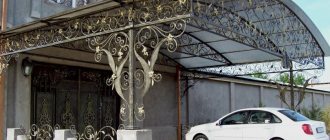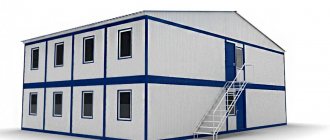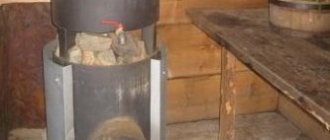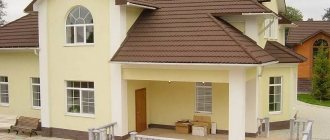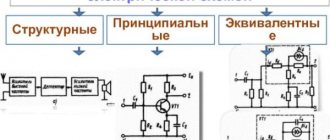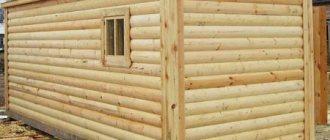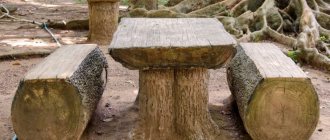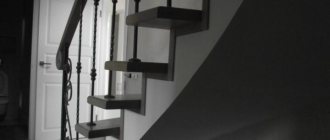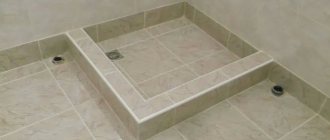The popularity of flat roofs in suburban housing construction is growing from year to year. Setting up a flat crawl is not as simple a task as it seems; the design has advantages and disadvantages, and the construction of flat roofs is a multilayer structure. The article compares the most common flat roofs, from traditional and inversion, to ventilated, green and usable. Knowing the differences will help you choose the right model and confidently navigate the component materials and construction nuances.
The purpose and design of a flat roof varies from project to project Source pinterest.ru
About flat roofing and its operation
Unlike a pitched roof, this roof is a single plane, the slope of which can vary from 2 to 15-20° (the minimum slope is needed for water drainage). This design is often called roofless; at the stage of housing design, they choose its type, which is easier to determine by the method of use:
- Exploitable . This implies its practical (often year-round) use. The roof is connected to the living quarters by an entrance; a recreation area, a flower garden, a solarium, and a sports ground are arranged on it. The structure is laid and erected taking into account high loads.
- Not in use . The owner appears here only when necessary, for inspection or repairs.
Flat roofs are traditionally common in southern regions with little snowy winters, but there are no direct prohibitions on the construction of such a structure in the northern regions. Contrary to popular belief, their operation is not significantly affected by wind strength or the amount of precipitation in winter.
Operable roof Source paradunato.net
How to raise rafters up
The comments suggested a great way:
Pulley hoist. Cheaper and faster. We install a 100*100mm stand. 6M vertically. We temporarily attach it to the outer wall. We stack the trusses under this wall from the outside.
We lift them one by one with a pulley hoist. Then we wrap it around this crane stand and release the pulley and lower it onto the walls. And so are all farms. Then we simply take them apart and move them along the walls throughout the house.
The main thing is to cling the rafters to the desired side (mirror image).
A pulley block is also called a double block roller. Sold in climbing equipment stores. You need two of these. And three carbines. Ropes 30 meters. The whole set costs about 3,000 rubles. We use it all the time to lift walls, trusses and beams. Up to 400 kg can be lifted.
About the advantages and disadvantages
A flat roof has the following attractive qualities:
- Economical construction . With the same area of the house, the area of the flat surface is less than that of the pitched surface; this means reduced costs for materials and components.
- Simple and quick installation . To equip a flat roof pie, you do not need to first purchase lumber and install sheathing. The extreme nature of installation work on a flat surface is reduced to a minimum; insurance is not needed here, so the labor intensity and time of installation work is reduced.
- Use for technical needs . A flat surface is a convenient place for mounting solar panels or climate control equipment. The facade of the house will not be damaged by external air conditioning units.
- Long service life . The flat roof is designed to last a long time and does not require expensive annual maintenance. Its reliability is guaranteed by compliance with building codes and proper organization of drainage.
Solar panels on a flat roof Source hs-projekt.pl
- Simplified maintenance . In order to inspect the chimney or ventilation duct, or clean the drain, you (or the specialist you invite) will not need the skills of a climber.
- Design possibilities . A flat roof is a necessary detail for many modern-style house projects, giving them a complete, exclusive look.
- Additional usable space . The usable roof included in the project allows you to equip a terrace, sauna or swimming pool, create a lawn or a small garden.
There are circumstances in which a flat roof may be inferior to a pitched roof. For example, a roof built without taking into account local climatic conditions may suffer from snow loads for which it was not designed. Most of the disadvantages of flat roofing are related to construction problems. Incorrect installation, violation of construction regulations, errors in drainage arrangement lead to a violation of the integrity of the structure and leaks. A well-equipped flat roof is, in many respects, a more profitable and functional option when compared with other structures.
Relaxation area Source mebel-go.ru
Selecting a Finish
Since wood is a fire-hazardous material, and the load-bearing capacity of beams is less than that of a reinforced concrete slab, for the final coating it is best to choose lightweight materials that do not require the use of burners during installation. A polymer membrane would be an ideal option. If you choose built-on waterproofing, the first layer will still have to be secured mechanically. And use non-flammable DSP as a base.
To make the roof usable, choose lightweight materials - deck boards, decking, and it is better to buy paving slabs made of rubber. It is enough to correctly calculate the load and carry out all the work correctly, then the roof on wooden beams will serve you faithfully.
Varieties and distinctive features of different types of roofs
In modern private housing construction, there are several ways to arrange a flat roof, which have some differences in the order of layers and the composition of the roofing pie.
Traditional roof
The composition of a traditional flat roof (also called soft), regardless of the slope, includes several layers:
- Base . Usually this is a reinforced concrete slab or metal profile structure.
- Vapor barrier . It is laid directly on the base and protects the overlying layer from diffuse moisture penetrating from below. The layer is made of roll or bitumen materials.
- Thermal insulation . The insulation is often one or two layers of mineral wool, polystyrene foam boards or PIR boards. It is acceptable to use expanded clay gravel or install a cement screed.
- Waterproofing . Protects underlying layers from atmospheric moisture. To organize it, bitumen-based materials are used: various rolled materials, as well as mastics or PVC membranes.
Installation of traditional roofing Source projject.ru
- Finish coating . Its role is successfully fulfilled by modern brands of waterproofing materials. The use of sheet and piece materials is not recommended - a small slope and many joints create a high risk of leaks.
See also: Catalog of companies that specialize in roof repair and design.
Operated roof
The main advantage of this design is the opportunity to obtain and profitably use additional space, in the form of a cozy relaxation corner or a place for sports. The design is a multilayer structure, the characteristics of which are prescribed in SNiP. The rules describe the procedure for arranging a roof in use; A cross-section of the pie with dimensions can be studied there. The operating coating has the following differences from the traditional design:
- A slope-forming layer is laid above the reinforced concrete base .
- Between the layer of insulation and waterproofing, a screed is made (at the correct angle) or fiberglass is laid.
Pie with tiled coating Source tupikov.ru
- Between the layer of waterproofing and the final (finishing) coating, an additional layer of protective separator (layer of geotextile) is made.
Taking into account the peculiarities of use, the layers of the roofing cake are arranged in accordance with the following conditions:
- Base . It must be rigid and capable of maintaining the integrity of the waterproofing.
- Insulation . The thermal insulation layer in such a roof is under constant load, both dynamic and static, therefore, the main requirement for this layer is to have sufficient compressive strength. If the material is not rigid enough, it is reinforced with a layer of cement screed. One of the modern solutions is PIR boards. They are rigid and strong enough to withstand the loads during operation and at the same time light, which allows them not to overload the roof structure.
- Finishing . The most popular option for finishing material is paving slabs, which are installed on special stands or a sand cushion, which allows the pressure to be distributed more evenly. If it is expected that the operation will be significant, experts recommend installing an inversion-type flat roofing pie.
Frame
To create a flat roof frame, choose beams with a cross section of 100-160 mm. They are laid according to the standard for interfloor slabs. Suitable for work are elements made from several composite (glued) parts, as well as lumber of the required (fixed) size and length.
Installation of a flat roof necessarily (by default) implies a slight slope of the future roof by 1-6 degrees. This is necessary so that the collected water from precipitation and melting snow flows freely towards the drain and does not stagnate. Professionals recommend installing the slope in several ways:
The most common option is to use beams with an already prepared slope. A reliable method of installation is to secure a reliable timber purlin along the top of the load-bearing wall (can be replaced with durable boards). It will carefully lift the entire frame of beams on one side and provide the required roof slope.
There is another way, when they create short radial beams. They are pulled from the double central one (diagonally).
Beam calculations
The number of beams to create a flat roof is calculated according to the expected load. SNiPs do not have clear instructions on choosing the section of boards; the main thing is not to skimp on the thickness of the lumber.
The specific pitch between the beams also depends on the further load on the structure and can range from 50 mm to 120-125 mm.
The nuances of leaning on walls
The frame of beams is mounted with obligatory emphasis on the walls, as in the assembly of interfloor ceilings. In a frame or wooden structure, the beams are laid with support on a crown (on top) of logs or frame.
When designing a building from brick or blocks, first create a mauerlat (from timber measuring 150 mm by 100 mm-150 mm), fix it on studs or anchors. Next, a frame of beams is attached to it, in which undercuts are made in advance for a tight connection with the Mauerlat. Fixation is carried out using reliable metal corners and nails.
Important! It is necessary to reliably protect the Mauerlat - builders lay out a layer of waterproofing between it and the walls. For example, roofing felt, this guarantees wear resistance and strength.
Video description
About flat roofing in use in the following video:
Inversion roofing
The main problem with a traditionally installed structure is the regular cycles of freezing and thawing that are common in our climate. The vulnerability of the outer layer to seasonal temperature fluctuations and solar radiation disappears after the installation of an inversion coating.
Unlike a traditional roof, here the thermal insulation is laid not under, but above the waterproofing. The insulating layer on top is protected by a ballast layer from mechanical pressure, temperature changes and sunlight with its destructive ultraviolet radiation. The roofing pie looks like this:
- A layer of waterproofing is laid on the concrete . Euroroofing felt, PVC membrane or bitumen mastics cope with this role.
- Thermal insulation is being installed . The assigned function is best accomplished by extruded polystyrene foam and PIR boards - synthetic materials characterized by high compressive strength and extremely low water and vapor permeability.
- A geotextile covering is laid and drainage is arranged.
Design of a flat inversion roof Source krovly.com.ua
- The top (ballast) layer , which plays a protective role, is made of gravel (bulk version), tiles are laid on top. On such a surface you can not only lay out a lawn and flower garden, but also without fear create a terrace, place chairs, a tea table or sun loungers.
See also: Catalog of flat-roof house projects presented at the Low-Rise Country exhibition.
Non-operational design
If paths, flower beds or a recreation area are not intended to be placed on the roof, it will be much easier (and cheaper) to equip it. Such a surface is not demanding on the parameters of the insulating layer and the overall strength of the base. At the same time, such simplification of requirements means a reduction in the service life of the surface.
Soft roofing materials
When installing flat roofs, at the initial stage it is necessary to prepare all roofing materials for further use.
If roll materials are used, they are carefully inspected for the presence of various types of defects: cracks, unevenness, oil stains. After this, they are rolled out and kept in this form or turned inside out for 24 hours.
Roofing mastic performs two functions simultaneously:
- It is used as an independent material to provide a seamless coating and for repair work.
- Used as an adhesive for joining roll-type materials to the base. Bitumen mastics are used both cold and hot.
Mastic as an independent roofing material
Flat structures do not always include rolled materials: they can be constructed using only mastic.
Mastic is essentially a liquid material made from pure elastic hydrophobic polyurethane resins. After application to the surface of a flat roof, under the influence of moisture contained in the air, the process of its polymerization begins, as a result of which the material is transformed into a rubber-like continuous membrane with excellent waterproofing and protective properties.
Due to a number of features, mastic is an almost ideal material for constructing flat structures. Its main advantages:
- reliability;
- safety;
- resistance to ultraviolet irradiation;
- resistance to precipitation and the development of microorganisms;
- excellent adhesion to any type of building surface;
- maintaining the original volume (it does not change even as a result of polymerization);
- ease of use: liquid mastic can be applied manually - using a roller or brush, or using a special method of airless spraying.
Roll materials for roofing
An important part of a flat roof is the roofing material itself. Rolled materials are most suitable for flat structures. They are laid over the surface with an overlap. If the roof slope is greater than 5%, the overlap in the internal carpet layers should be 70 mm, in the external layers - 100 mm. With a slope of less than 5%, the overlap width in all layers is 100 millimeters or more. Roll strips are laid in a certain (one) direction.
If during the gluing process the panel deviates to the side, you must try to move it without peeling it off. If there is no result or its insufficiency, the glued part is cut off and glued with a 100 mm overlap.
Laying of roll sheets is carried out layer by layer. When attaching them to cold mastic, a 12-hour interval must be observed between gluing layers.
Video description
About the intricacies of a flat roof in the following video:
Breathable (ventilated) roof
The reason why roofing structures lose their properties over time is due to waterlogging of the heat-insulating layer. Undesirable changes are especially accelerated in the summer, when the temperature rises and increased evaporation of moisture from the insulation begins. The consequences are visible to the naked eye - swellings and tears form on the roof surface, and cracks form. Sooner or later, the destructive process ends with a violation of the integrity of the roofing pie and peeling of the coating from the base.
To prevent destruction, the roof structure is made breathable (ventilated); this neutralizes the formation of condensation and ensures high-quality removal of water vapor. The flat roof structure is undergoing significant changes; The roofing carpet of the ventilated covering consists of the following elements:
- A floor slab on which layers of vapor barrier and insulation .
- Cement-sand screed.
- The bottom layer of multi-layer waterproofing . Usually this is a layer of euroroofing material (Uniflex VENT), which prevents swelling.
Flat roof ventilation diagram Source regionzap.ru
- Waterproofing layer . Polymer-bitumen (SBS) binder, providing additional sealing.
- The top layer of multi-layer waterproofing . Uniflex EKP (TKP).
- Roof fans (aerators).
- Expanded clay gravel.
- Final roll coating .
This design solution can be used both when constructing a new roof and when repairing an old one. In the latter case, the installation of a ventilated covering can be carried out without removing the old fused roofing carpet, which will serve as an additional layer of waterproofing. If a new layer is created with a slope, this will ensure high-quality outflow of water and extend the service life of the structure.
Roofing units
To reliably protect the roofing pie from external influences, special care must be taken in areas where it adjoins building structures such as parapets, walls, pipes, external parts of ventilation systems, etc.
The main components of a flat roof are:
- junction unit;
- overhang unit;
- roof passage unit.
The units are installed on a reinforced concrete base in those areas where the cut of the roofing pie is adjacent to vertical structures. Often, manufacturers of roofing materials develop their own systems: each of them may have certain design features.
The main requirement for the units is to ensure the tightness of the joint and its thermal protection.
Video description
About green roofs in the following video:
- A layer of insulation is laid ; It is appropriate to use extruded materials here.
- Geotextiles are laid (or better yet, two layers, with a profiled membrane between them, which will allow soil pressure to be more evenly distributed).
- Drainage layer . Gravel or crushed stone is used.
- A filter layer that simultaneously protects the root system of plants.
- Soil and green spaces.
Green roof design diagram Source stroyfora.ru
Green roofs, depending on the nature of operation and the amount of landscaping, are divided into two types:
- Extensive . Not designed for constant human presence. The soil layer is laid thin in thickness (up to 15 cm); Only lawn grass is sown, and flowers and ornamental shrubs are planted in pots or special containers.
Extensive green roof Source pinterest.co.uk
- Intense . If the design of the house allows you to lay a layer of soil 0.3-0.6 m thick (the total thickness of the roofing carpet reaches 1.2 m), you can set up a full-fledged garden with trees and lush flower beds on the roof. The installation of such a structure should be entrusted to professionals; Repairing a green roof made by hand is a time-consuming, problematic and expensive task.
Reviews
Developers' opinions about horizontal roofs are expectedly opposite . Some do not consider themselves fans of cubism; they believe that such aesthetics are not for Russia. And others are delighted with the laconic lines of unusual architecture.
Some believe that a powerful supporting system of a house with a roof terrace requires a foundation of increased strength, which cannot but affect the rise in cost of the project. Others say that a flat structure can be made independently, without involving paid labor and rented equipment.
Many who dream of a flat roof note the need for complex waterproofing and are afraid that they will have to spend the entire winter on the roof clearing snow. But there are also many who are overwhelmed with emotions from having created a real paradise on the roof.
You can get acquainted with the discussions about flat roofs in detail on thematic forums:
- yaplakal.com
- forumhouse.ru
- eva.ru
- forum.dwg.ru
Rules for using a flat roof
Operating a flat roof is no more difficult than a conventional gable roof. There are a number of rules, compliance with which during installation and further use will help extend the service life of the roofing:
- The roofing carpet should be protected from contact with organic solvents , gasoline or technical oil.
- The roof must be clean . Any debris, nails, forgotten pieces of reinforcement and wire left on the surface of the coating can compromise its integrity.
- It should be remembered that the bitumen-polymer materials included in the cake do not tolerate steam and temperatures above 45° .
- Regular inspection . During the melting of snow cover and autumn leaves, it is necessary to inspect gutters and funnels (at least twice a month).
Modern flat roof project Source archilovers.com
